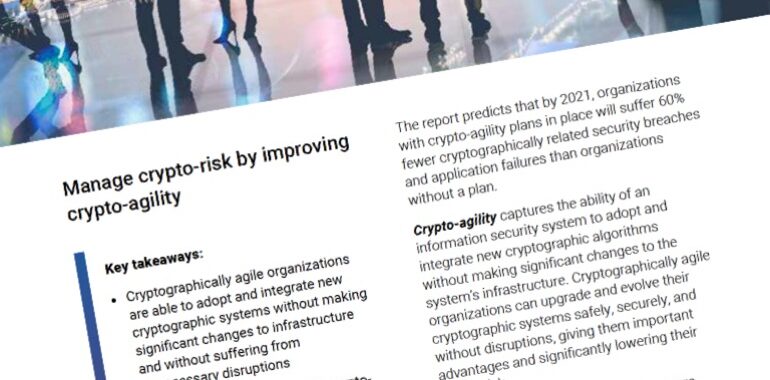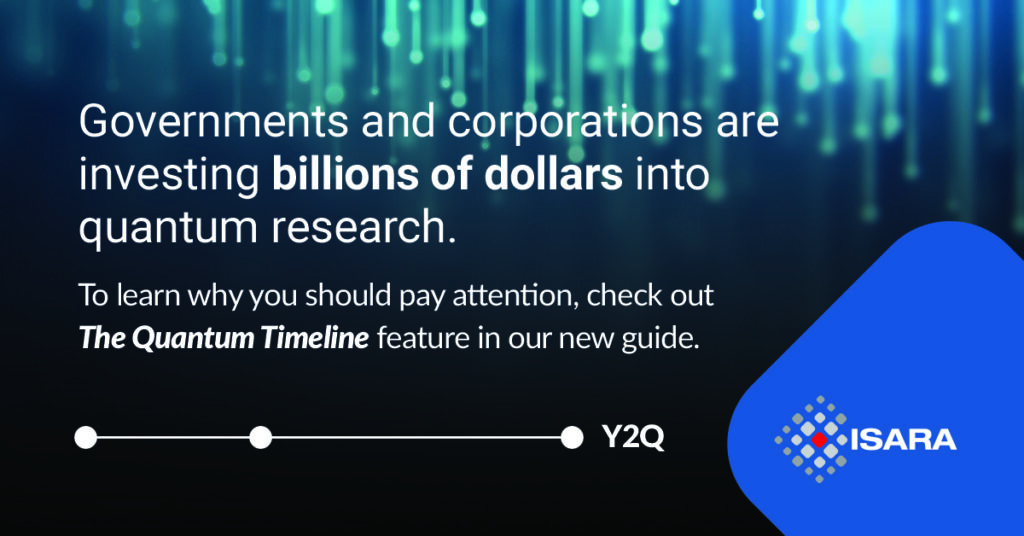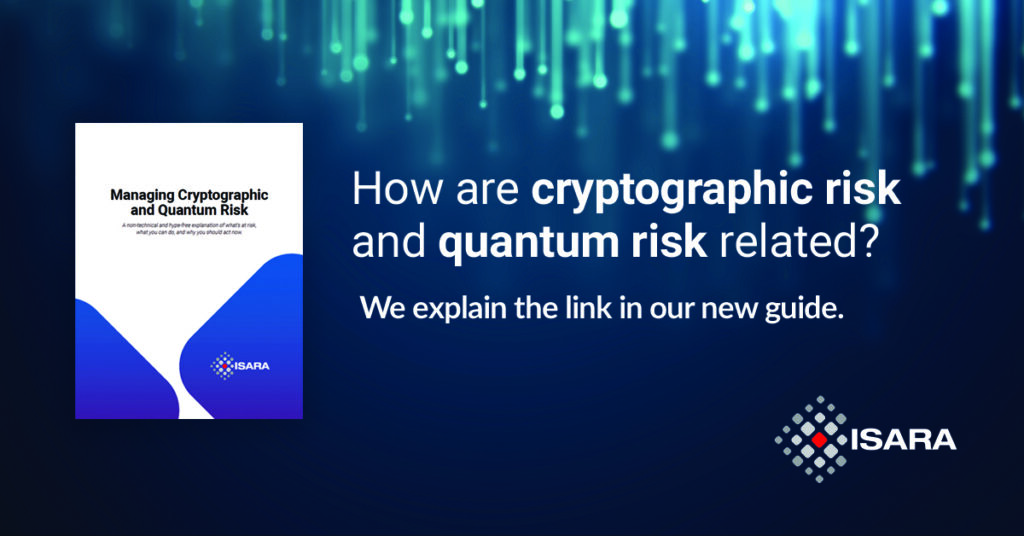ISARA grows awareness and demand with educational content
Many pixels have been lit up on this blog examining how B2B companies can overcome knowledge gaps when selling highly technical or very specific solutions—well, add to the list this post about creating educational content.
ISARA is a Waterloo-based company that tends to fly under the radar on the local tech scene, likely because the problems they solve don’t arise in everyday conversation.
What are those problems, you ask? Managing cryptographic risk and quantum risk.
If you don’t know what those are, don’t worry—you’re not alone. In fact, that’s precisely why ISARA reached out to Cromulent, which led to us producing a premium piece of educational content: Managing Cryptographic and Quantum Risk—A non-technical and hype-free explanation of what’s at risk, what you can do, and why you should act now.
With good reason, we believe this resource is the industry’s most comprehensive and authoritative exposition of these two complex, poorly understood—and vitally important—subjects.
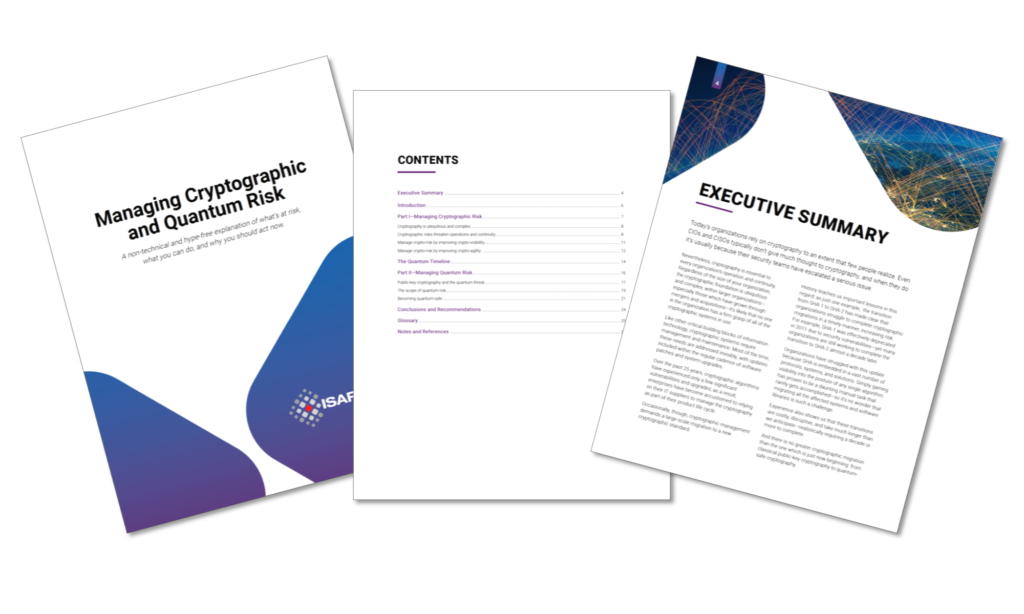
Background and Project Objective
ISARA is the world’s leading provider of crypto-agile and quantum-safe security solutions—and because of the RIM/BlackBerry experience of the team, they have particular expertise in building practical cryptographic systems for the constraints of real-world operational environments.
But being able to solve a problem only matters if you manage to get the opportunity to solve it, and you can only get the opportunity to solve it if people know the problem exists.
Unfortunately, cryptographic risk and quantum risk are intimidating subjects that aren’t well known and can be challenging to explain. This scenario is quite common in B2B tech, and it created three distinct needs for ISARA:
- Increase awareness of the problems, within ISARA’s target markets
- Create demand for solutions, within ISARA’s target markets
- Bridge the knowledge gap, so ISARA and their prospects can have productive conversations
The objective for this project was to address those three needs, effectively and efficiently.
Educational Content: A Crash Course in Two Complex Subjects
ISARA had previously commissioned an “Executive Guide” to provide an overview of quantum risk; that paper had done its job but was showing its age a bit (quantum advancements come fast and significant) and lacked ISARA branding. We decided to replace it with a piece of educational content carrying the ISARA brand; we also chose to use the opportunity to extend the subject matter to also include cryptographic risk.
Of course, there’s a trade-off that must be considered when deciding to cover two complex topics in one piece of educational content: while you get to convey two important things instead of just one (and explain the link between them), doing so comes at the expense of making the document longer.
In today’s lead generation-obsessed culture (where more content is always assumed to be better), many companies might have defaulted to creating two assets; however, we really wanted to capture the linkage between the two concepts, so we decided that a single authoritative piece was the way to go—and besides, we could always split the document in two at some point in the future.
Knowing your audience is the most important input to this decision—and we knew that ISARA’s audiences are accustomed to learning about tough subjects, so they aren’t likely to be put off by something that’s relatively longer compared to the bite-size content so popular nowadays.
Note: Recall that the same understanding of target audience contributed to Miovision’s extremely successful Clear Signals ebook.
Plus, you can only condense something so far before obscuring or overlooking important details. We wanted to create a piece of educational content that clearly, consistently, and correctly explained the subject matter—those intentions took priority over concerns about length.
Nevertheless, there is obvious value in making something that is easily digestible, so from the outset we intended to create a perusable document: that is, even if a reader only casually flicked through, they’d still be able to extract important takeaways without examining the body in detail.
Crucially, we also aimed to produce a resource that was understandable by non-technical, non-expert readers—and we made this point clear in the sub-title: “A non-technical and hype-free explanation of what’s at risk, what you can do, and why you should act now.”
Our intended audience included CEOs, CIOs, CISOs, and IT department heads; that meant we could take for granted some familiarity with everyday technology concepts, but in general these functional leaders are not experts in cryptography or quantum security.
Beginning with the End in Mind
Once our goals were identified, we at Cromulent had in mind a particular outline for the document:
- A high-impact executive summary that identifies the problems and creates a sense of urgency; if this section was the only part that someone looked at, we wanted them to appreciate the magnitude of the problems
- Two body sections—one for each subject—with each having its own ‘cover’ page to introduce the topic and with subsections to explain the problem, outline the risks, and examine solutions
- A centrefold-style feature between the two body sections showing the progress of quantum research and engineering (see the image below), to combat the perception that quantum issues are so far off that they can be ignored for the time being
- A tight conclusion to wrap it together and inspire action
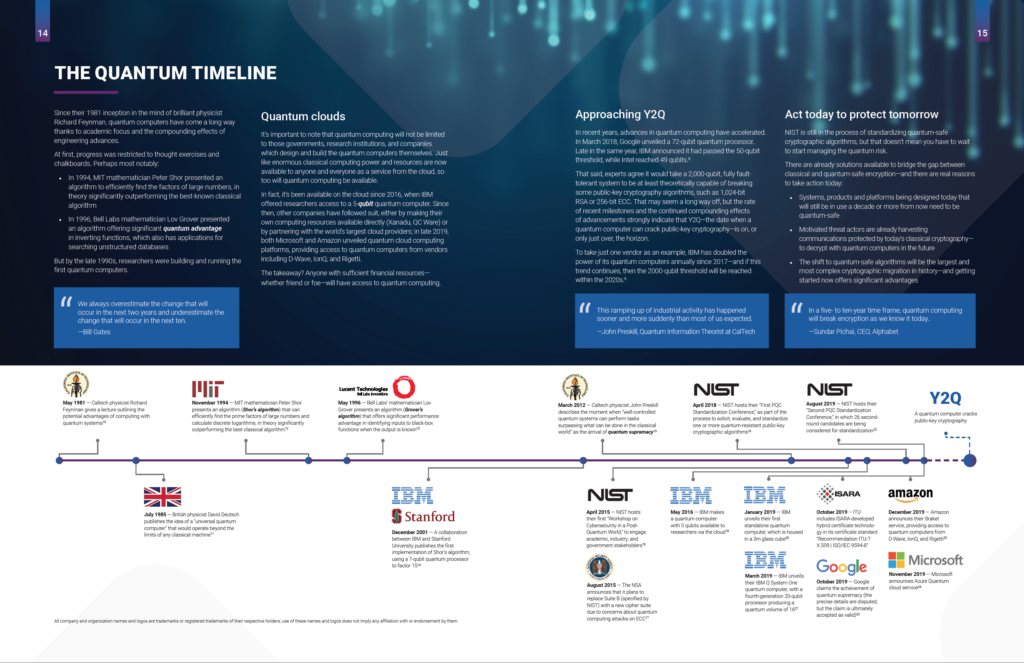
Also from the outset, we knew we wanted to include:
- Key takeaway bullets at the beginning of each body subsection (see image below), to permit the flick-through reader to get value
- A helpful glossary, since so many of the terms we needed to use are unfamiliar and defining them (in detail) throughout the body would be quite unwieldy—our Glossary page explained 19 domain-specific terms
- As many external references as was necessary to demonstrate that this document was not a highly skewed editorial piece, but instead represented an authoritative exposition grounded in facts—when all was said and done, the Notes and References page contained 30 entries
Having this clear vision in mind before we started researching and writing was enormously useful. In all honesty, the subject matter was pretty intimidating and required complete focus. Having the end in mind let us mentally put things in the right place as we went along through the learning process.

Listen, Regurgitate, Inquire, Understand, Extend
Whenever we Cromufolk tackle a new subject, we tend to go through a number of steps:
- Listen: we had conversations with ISARA’s experts and feverishly wrote down everything they said; based on our general latticework of technical knowledge, at this stage we’re able to ask some reasonably technical questions, but nothing terribly domain-specific
- Regurgitate: the earliest content chunks within the paper consisted of regurgitations of what we had been told; we’re able to reword some things, and the process of trying to build the narrative reveals gaps in our knowledge
- Inquire: as our new knowledge framework takes form, we perform research and ask detailed follow-up questions to fill gaps, seek clarification, link concepts, etc.—as is frequently the case, our outsider perspective forces us to ask many of the same questions that ISARA’s target audiences would ask
- Understand: we being to have little “Aha!” moments where things suddenly click—it’s a great feeling!—and there’s an inflection point where we transition from “Oh man, this is a mess…” to “Wow, this is gonna be a great piece of content!!!”
- Extend: with our newfound understanding in place, we’re now able to genuinely go beyond what we’ve been told or what we discovered through research—introducing our own explanations, revisiting and revising things we had regurgitated, and so on
For relatively easier domains, this process might play out in an afternoon. For these two subjects—cryptographic risk and quantum risk—it extended over a couple of weeks. There’s always a certain amount of faith involved: I don’t quite ‘get it’ yet, but I will ‘get it’ at some point.
Then it was just a matter of moving pieces around, polishing the draft, having a general review, and then fine-tuning some especially tricky paragraphs.
…Back to the Goals
OK, so we’ve produced a premium piece of educational content and had fun extending our latticework of technical knowledge. But how are we doing with respect to our goals?
Goal #3: Bridge the knowledge gap: The document itself bridges the knowledge gap by explaining two unfamiliar, complex subjects and linking them in a meaningful way. Feedback indicated that people who read it ‘got it’ and really valued the clarity with which we examined the subjects.
Goal #2: Create demand for solutions: The document creates demand by presenting the benefits of taking action now and the very real risks of choosing (it’s always a choice!) inaction. It shows that even organizations who legitimately don’t need to take action now to combat quantum risk should nevertheless be taking steps today to manage cryptographic risk (whether for its own benefits or as preparation for the coming quantum migration).
Additionally, the centrefold feature—The Quantum Timeline—serves to visually showcase that the pace of quantum breakthroughs is increasing, combatting the perception that this is a problem for the next generation of a company’s or organization’s leaders to worry about.
That same feature really elevates the ISARA brand, too, by placing it alongside heavyweights including Google, IBM, and Microsoft.
But what about Goal #1: Increase awareness of the problems? To increase awareness, you need to:
- Get your content in front of people
- Clearly convey your message
There is no doubt that this resource achieves the second part. And it’s important to note that ISARA’s team is made up of seasoned, well-connected industry professionals, so this paper will travel far and wide simply through those connections alone.
But to help with that first part—extending beyond the existing network—we also provided graphic cards for use in social media promotions.
A Few Key Points
This has been a long post, so I think it’s worthwhile to highlight a few things that might have been skipped over along the way.
To review: this project delivered a 28-page piece of educational content which presented two very complex subjects and was written and structured in such a way as to be understandable by readers who don’t have any special technical knowledge.
But why was this the right content? It comes down to a few things:
- We had specific objectives, and we started with those. That is, we didn’t go, “Hey, let’s write a long paper!” It just turned out that a comprehensive paper was an effective way to achieve our goals.
- We knew our target audiences. And because of that, we knew that they would be receptive to a longer-form asset.
- We catered to the skim-through reader. Sure, the resource itself is comprehensive, but even a reader who gives it a cursory flick-through can pick up important points.
Perhaps most importantly, we knew that by creating this resource, we were addressing real market needs.
Cryptographic risk and quantum risk are tough subjects; if you had no prior domain knowledge and sat down in front of an open search engine page, it would almost certainly take you a very long time to develop an understanding of the subjects and an appreciation for what they mean to your business or organization—far, far longer than it would take to read this document.
By providing an objective and authoritative crash course in these subjects, ISARA has done the market a real service.

